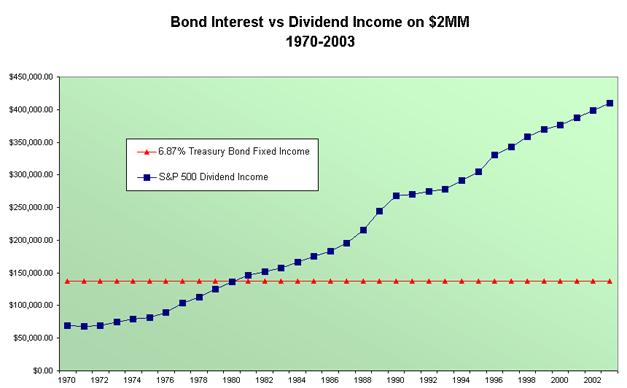Tim, our "conservative" investor opts for the 30-year Treasury bond. Not only does the Treasury bond yield much more than stocks, it comes with the 100% absolute guarantee of the US Government that the principal will be repaid in thirty years. And the $68,700 per year in bond interest will be more than enough to fund his retirement. Not much of a choice, is there?
Bill, on the other hand, watched his parents gradually out-live their fixed retirement income a generation ago. He remembers all too well watching them eliminate travel, downsize their home into a condo, and drop their membership at their beloved country club. Bill saw firsthand how rising costs slowly but surely erode the purchasing power of a fixed income. As a result, Bill reasons that he can afford to take a lower initial income stream in exchange for participating in the growth that equities have historically provided. He is more than willing to accept some short-term fluctuations in his portfolio in order to secure a long and happy retirement.
Fast-forwarding 33 years to 2003 reveals who took the riskier path. In 2003 dollars, both retirees now need $130,000 per year to maintain their same lifestyle. The bond income that was more than enough in 1970 is no longer sufficient to buy Tim's groceries, pay his medical bills, etc. As a result, Tim was forced to liquidate some of his bond shares, further reducing his income. To further complicate matters, the yield on a 10-year treasury bond in 2003 has fallen to approximately 3.5%. Tim can now only generate $33,500 by reinvesting his original $1,000,000 in today's Treasury bonds. The longer he lives, the worse his lifestyle will become. A "conservative" investment plan all but doomed poor Tim to a life of poverty - just like it had done to Bill's parents years ago.

On the other hand, Bill's $1,000,000 portfolio invested in the S&P 500 is now paying out over $200,000 per year in dividends alone - more than enough to meet his new $130,000 per year living expenses. And despite the two worst bear markets since the Great Depression (1973-74) and (2000-02), Bill's $1,000,000 initial principal is now worth well over $8,000,000. By accepting some short-term fluctuations in his portfolio, Bill has managed to secure an ever-increasing income stream that he could not possibly outlive. He knows that is only real definition of financial independence.
As a practical matter, it is often easier emotionally on retirees to invest the bulk of their money in a stock portfolio, but to leave two years worth of living expenses in cash or short-term instruments. This creates an emergency fund can be used to fund retirement during the next prolonged bear market. This can help alleviate some of the emotional stress that accompanies taking portfolio withdrawals from a portfolio that has declined in value. Investors who acknowledge that bear markets are a normal, healthy part of investing can be well equipped to deal with them - even in retirement.
Previous Lesson: Stocks = Owner | Table of Contents | Next Lesson: Diversification
